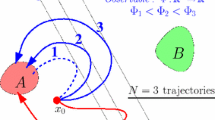Abstract
In this paper, we improve the existing analysis on the randomized radioactive decay chain model based on Bateman master equations, by Hussein and Selim (2020). For a decay chain of three species of radionuclides, the authors derived the probability density function for the concentrations, by using the random variable transformation technique. We extend this application to the general solution of Bateman equations. The density function is expressed as an expectation, which has important implications for parametric density estimation. This may improve the classical kernel estimation when the random dimensionality is not low. Numerical examples are included, where the decay parameters and the initial concentrations are assigned different probability distributions.



Similar content being viewed by others
Data availability
Data sharing not applicable to this article as no datasets were generated or analyzed during the current study.
References
A. Hussein, M.M. Selim, Eur. Phys. J. Plus. 135(5), 418 (2020). https://doi.org/10.1140/epjp/s13360-020-00389-6
T. Neckel, F. Rupp, Random Differential Equations in Scientific Computing, (Walter de Gruyter, 2013)
R.C. Smith, Uncertainty Quantification: Theory, Implementation, and Applications, (SIAM, 2013)
A. Hussein, M.M. Selim, Eur. Phys. J. Plus. 130(12), 249 (2015). https://doi.org/10.1140/epjp/i2015-15249-3
F.A. Dorini, M.S. Cecconello, L.B. Dorini, Commun. Nonlinear Sci. Numer. Simulat. 33, 160–173 (2016). https://doi.org/10.1016/j.cnsns.2015.09.009
H. Slama, N.A. El-Bedwhey, A. El-Depsy, M.M. Selim, Eur. Phys. J. Plus. 132(12), 505 (2017). https://doi.org/10.1140/epjp/i2017-11763-6
J. Calatayud, J.C. Cortés, F.A. Dorini, Fluct. Noise Lett. 20(4), 2150038 (2021). https://doi.org/10.1142/S0219477521500383
T.T. Soong, Random Differential Equations in Science and Engineering (Academic Press, New York, 1973)
W.J. Padgett, G. Schultz, C.P. Tsokos, SIAM, J. Appl. Math. 32(2), 467–483 (1977). https://doi.org/10.1137/0132039
M. Ehrendorfer, Mon. Weather Rev. 122(4), 714–728 (1994)
A. Halder, R. Bhattacharya, J. Guid. Control Dynam. 34(2), 459–474 (2011). https://doi.org/10.2514/1.51196
J.-C. Cortés, M. Jornet, Math. Comput. Appl. 25(2), 33–41 (2020). https://doi.org/10.3390/mca25020033
H. Bateman, Proc. Camb. Philos. Soc. 15, 423–427 (1910)
G. Casella, R.L. Berger, Statistical Inference, 2nd edn. (Duxbury Pacific Grove, CA, 2002)
Z. Botev, A. Ridder, Wiley StatsRef: Statistics Reference Online, pp. 1–6 (2017). https://doi.org/10.1002/9781118445112.stat07975
B.W Silverman, Density Estimation for Statistics and Data Analysis, (Chapman and Hall, 1986)
M. Jornet, J. Calatayud, O.P. Le Maître, J.-C. Cortés, J. Comput. Appl. Math. 374, 112770 (2020). https://doi.org/10.1016/j.cam.2020.112770
M. Jornet, J. Calatayud, O.P. Le Maître, J.-C. Cortés, Int. J. Uncertain. Quant. 10(5), 467–497 (2020). https://doi.org/10.1615/Int.J.UncertaintyQuantification.2020032659
F. Udwadia, SIAM Rev. 31(1), 103–109 (1989). https://doi.org/10.1137/1031004
F.A. Dorini, R. Sampaio, J. Appl. Mech. 79(5), 051008–051014 (2012). https://doi.org/10.1115/1.4006453
M. Jornet, Stoch. Anal. Appl. 39, 22–32 (2021). https://doi.org/10.1080/07362994.2020.1777163
Funding
Marc Jornet has been supported by a postdoctoral contract from Universitat Jaume I, Spain (Acció 3.2 del Pla de Promoció de la Investigació de la Universitat Jaume I per a l’any 2020).
Author information
Authors and Affiliations
Corresponding author
Ethics declarations
Conflict of interest
The authors declare that there is no conflict of interests regarding the publication of this article.
Appendix
Appendix
We prove (2). Let \({\mathcal {C}}\) be a Borel set in \({\mathbb {R}}\). By definition of conditional law,
Since A has a PDF,
By Fubini’s Theorem (justified because the integrand is nonnegative) and the expression of the expectation,
This proves (2).
Though not used in the current paper, (2) may be generalized as follows. Let \(\pmb {A}\) be an absolutely continuous random vector of length m. Let \(\pmb {M}\) be an \(m\times m\) random matrix and \(\pmb {Z}\) be a random vector of length m. Suppose that \(\pmb {A}\) is independent of \((\pmb {M},\pmb {Z})\) and that \(\pmb {M}\) is invertible almost surely. Then, \(\pmb {M}\pmb {A}+\pmb {Z}\) is absolutely continuous, with PDF
Rights and permissions
About this article
Cite this article
Calatayud, J., Jornet, M. Extending the applicability of the RVT technique for the randomized radioactive decay chain model. Eur. Phys. J. Plus 137, 405 (2022). https://doi.org/10.1140/epjp/s13360-022-02625-7
Received:
Accepted:
Published:
DOI: https://doi.org/10.1140/epjp/s13360-022-02625-7




